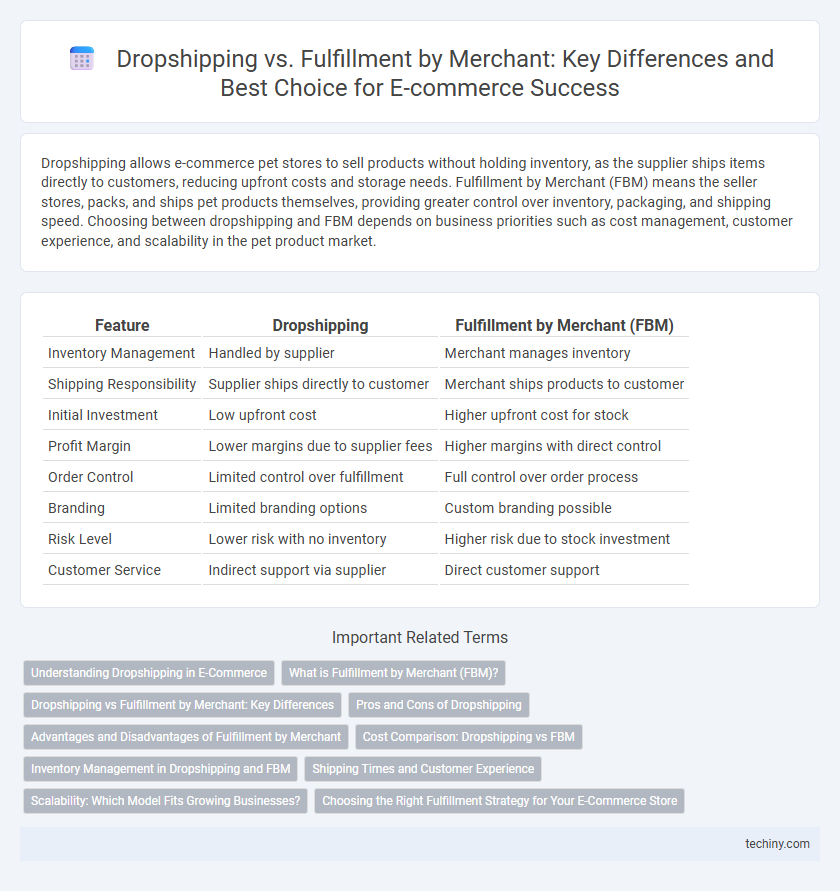Dropshipping allows e-commerce pet stores to sell products without holding inventory, as the supplier ships items directly to customers, reducing upfront costs and storage needs. Fulfillment by Merchant (FBM) means the seller stores, packs, and ships pet products themselves, providing greater control over inventory, packaging, and shipping speed. Choosing between dropshipping and FBM depends on business priorities such as cost management, customer experience, and scalability in the pet product market.
Table of Comparison
| Feature | Dropshipping | Fulfillment by Merchant (FBM) |
|---|---|---|
| Inventory Management | Handled by supplier | Merchant manages inventory |
| Shipping Responsibility | Supplier ships directly to customer | Merchant ships products to customer |
| Initial Investment | Low upfront cost | Higher upfront cost for stock |
| Profit Margin | Lower margins due to supplier fees | Higher margins with direct control |
| Order Control | Limited control over fulfillment | Full control over order process |
| Branding | Limited branding options | Custom branding possible |
| Risk Level | Lower risk with no inventory | Higher risk due to stock investment |
| Customer Service | Indirect support via supplier | Direct customer support |
Understanding Dropshipping in E-Commerce
Dropshipping in e-commerce allows retailers to sell products without holding inventory by partnering with suppliers who ship orders directly to customers. This model reduces upfront investment and minimizes storage costs but requires reliable supplier coordination to maintain customer satisfaction. Efficient dropshipping demands seamless order management and clear communication to ensure timely delivery and accurate product information.
What is Fulfillment by Merchant (FBM)?
Fulfillment by Merchant (FBM) is an e-commerce order fulfillment method where the seller stores inventory and handles packaging, shipping, and customer service independently without relying on third-party logistics providers. This approach allows sellers to maintain control over inventory management and shipping speed while reducing fees associated with third-party fulfillment services. FBM is commonly used by small to medium-sized businesses seeking flexibility and direct oversight of their supply chain operations.
Dropshipping vs Fulfillment by Merchant: Key Differences
Dropshipping involves selling products without holding inventory, where orders are directly fulfilled by a third-party supplier, minimizing upfront costs and inventory risk. Fulfillment by Merchant (FBM) requires sellers to store, pack, and ship products themselves, offering greater control over inventory and shipping speed. Key differences include inventory management responsibility, shipping control, and upfront investment, influencing scalability and customer experience in e-commerce operations.
Pros and Cons of Dropshipping
Dropshipping offers low startup costs and eliminates the need for inventory management, allowing entrepreneurs to quickly test product demand without significant upfront investment. However, it presents challenges such as lower profit margins, limited control over shipping times, and potential supply chain inconsistencies that can affect customer satisfaction. Reliance on third-party suppliers increases the risk of stockouts and delays, which can harm brand reputation in competitive e-commerce markets.
Advantages and Disadvantages of Fulfillment by Merchant
Fulfillment by Merchant (FBM) allows e-commerce sellers to control inventory storage, packaging, and shipping, reducing reliance on third-party logistics and enabling personalized customer service. Sellers face disadvantages such as increased operational complexity, higher shipping costs, and slower delivery times, which can impact customer satisfaction and scalability. FBM offers flexibility for niche products but may struggle to compete with the fast shipping speeds and streamlined processes of dropshipping or Fulfillment by Amazon (FBA).
Cost Comparison: Dropshipping vs FBM
Dropshipping typically involves lower upfront investment and reduced inventory costs since products are shipped directly from suppliers, while Fulfillment by Merchant (FBM) requires more capital tied up in inventory and warehousing. FBM often incurs higher shipping and handling expenses due to merchants managing their own logistics, contrasting with dropshipping's supplier-handled shipping. Analyzing cost structures reveals dropshipping's advantage in scalability with minimal fixed costs, whereas FBM can achieve better profit margins per sale through bulk purchasing and direct shipping control.
Inventory Management in Dropshipping and FBM
Dropshipping inventory management relies on suppliers to stock and ship products directly to customers, eliminating the need for sellers to handle physical inventory and reducing overhead costs. In contrast, Fulfillment by Merchant (FBM) requires sellers to maintain and manage their own inventory, offering greater control over stock levels and shipping processes but increasing responsibility for storage and order fulfillment. Efficient inventory management in dropshipping minimizes stockouts and backorders by syncing supplier availability, while FBM necessitates accurate tracking and timely restocking to meet customer demand.
Shipping Times and Customer Experience
Dropshipping often results in longer shipping times due to reliance on third-party suppliers, which can negatively impact customer satisfaction and trust. Fulfillment by Merchant (FBM) allows sellers to control inventory and shipping processes, improving delivery speed and providing a more consistent customer experience. Efficient FBM operations enhance brand reliability and reduce complaints related to delayed shipments, directly influencing repeat purchases and positive reviews.
Scalability: Which Model Fits Growing Businesses?
Dropshipping offers scalability through minimal upfront investment and outsourced inventory management, allowing businesses to expand product ranges quickly without holding stock. Fulfillment by Merchant (FBM) requires more operational control and infrastructure but provides greater flexibility in inventory management and shipping, which can support scalable growth with personalized customer experiences. Growing businesses prioritizing rapid entry and lower risk often prefer dropshipping, while those aiming for brand control and consistent quality lean towards FBM for sustainable scalability.
Choosing the Right Fulfillment Strategy for Your E-Commerce Store
Choosing the right fulfillment strategy for your e-commerce store significantly impacts customer satisfaction and operational efficiency. Dropshipping allows entrepreneurs to sell products without holding inventory, reducing upfront costs but often resulting in longer shipping times and less control over product quality. Fulfillment by Merchant (FBM) offers greater control over inventory and shipping processes, enabling faster delivery and personalized packaging, which can enhance brand trust and customer loyalty.
Dropshipping vs Fulfillment by Merchant Infographic

 techiny.com
techiny.com